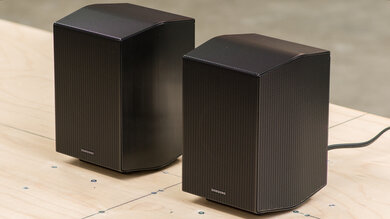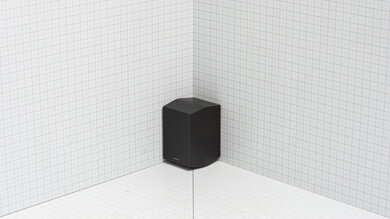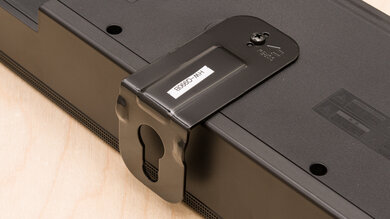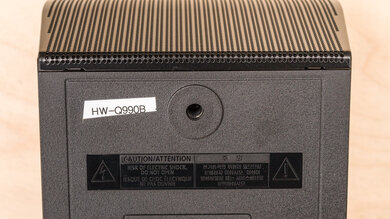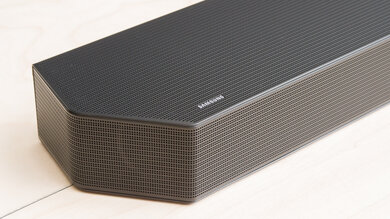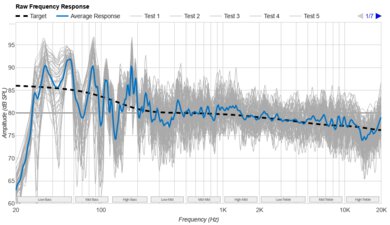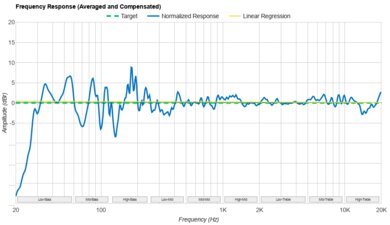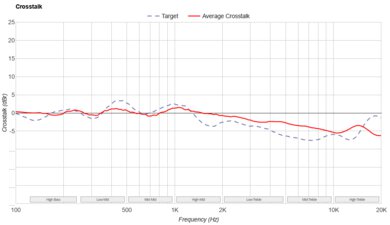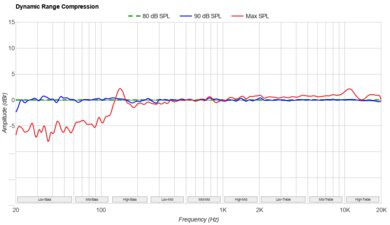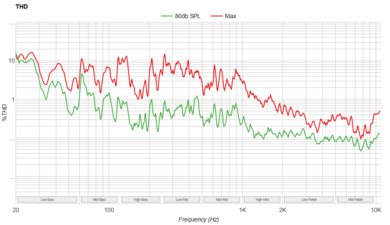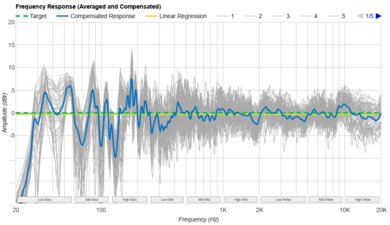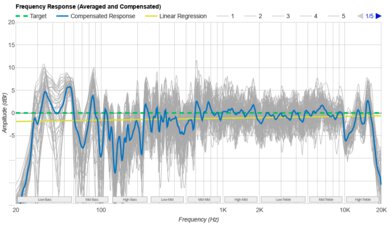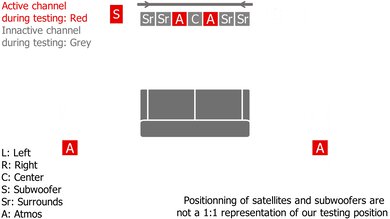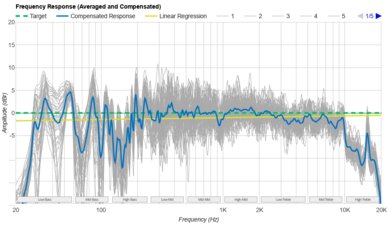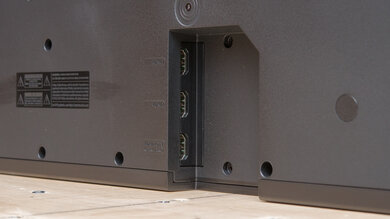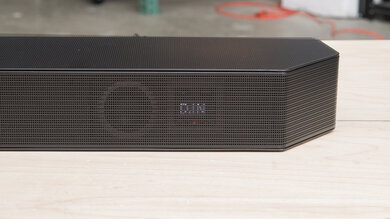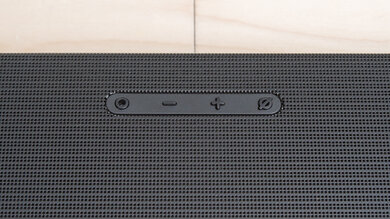The Sony HT-A9 is a premium setup with a very unique design. Instead of a wide soundbar, it comes with a small control box and four satellite speakers. Sony's 360 Spatial Sound technology is advertised to create a more immersive listening experience with a wide-sounding soundstage. It also has Sound Field Optimization to calibrate your setup based on your room's acoustics. It supports Atmos content, and it has a very immersive surround performance.
Note: You can upgrade the Sony HT-A9 with a subwoofer, which is sold separately. These results represent the standalone control box and satellites, but you can also see the results for the Sony HT-A9 with Bass Module.
Our Verdict
The Sony HT-A9 is satisfactory for mixed usage. This setup comes with a Sound Field Optimization room correction feature that optimizes audio reproduction based on your room's acoustics, which we turned on for our tests. It offers immersive surround and Atmos performances. While it struggles to reproduce a thumpy low-bass for bass-heavy music or action movies, it can still reproduce vocals and lead instruments pretty clearly. There's a little extra muddiness in the bass range, though, which may slightly thin out those same instruments. It also doesn't get very loud.
- Room correction feature.
- Fantastic soundstage.
- Lacks low-bass.
- Doesn't get very loud.
The Sony HT-A9 is decent for dialogue-centric content like TV shows. Thanks to its balanced mid-range, vocals are reproduced clearly and with detail, though they can also be thin. There's even a dialogue enhancement feature to make voices more clear and crisp. However, this setup lacks a discrete center channel, so voices seem to come from a more general area rather than an accurate, pinpoint location. That said, the manufacturer says that you can use compatible Sony TVs as a discrete center when paired to the setup.
- Dialogue enhancement mode.
- Phantom center channel.
The Sony HT-A9 is satisfactory for music. It has a Sound Field Optimization room correction feature that automatically calibrates audio reproduction based on your room's acoustics. On 'Standard Surround' mode, it reproduces vocals and lead instruments pretty clearly, though there's a little extra muddiness in the bass that may thin them out. Unfortunately, it can't reproduce the deep thump and rumble in bass-heavy genres like EDM. While there's a subwoofer level adjustment, it doesn't offer a lot of other sound customization options. Some of its sound features are also only available when using the full setup, like the subwoofer volume adjustment feature.
- Subwoofer level adjustment.
- Room correction feature.
- Lacks low-bass.
- No graphic EQ.
The Sony HT-A9 is decent for movies. On 'Standard Surround', it has a balanced mid-range that reproduces dialogue pretty clearly. Its four satellites offer an immersive surround sound experience, and you can also turn its up-firing speakers on and off using its Immersive AE feature. It also supports Dolby Atmos content. That said, it can't reproduce the deep rumble in action-packed scenes, and it doesn't get very loud.
- Room correction feature.
- Fantastic soundstage.
- Lacks low-bass.
- Doesn't get very loud.
Changelog
-
Updated Jan 30, 2025:
We added a reference to the Sony BRAVIA Theater Quad in the Dimensions - Satellites box.
- Updated Jul 31, 2024: We've added a comparison between this soundbar and the Sony BRAVIA Theater Quad with Bass Module in Style- Satellites.
- Updated Sep 14, 2023: Updated text in Video Passthrough to TV box for clarity. No changes in test results.
- Updated Sep 11, 2023: Updating the bar to firmware version 1.779 adds ALLM and HDMI Forum support. The Video Passthrough to TV score improves from 9.0 to 9.5 as a result.
Check Price
Differences Between Sizes And Variants
The Sony HT-A9 is available in 'Light Gray', and you can see the label for the model we tested here.
These results aren't valid for the full setup with the subwoofer, which is sold separately. You can also look at our results for the Sony HT-A9 with Bass Module.
If you come across another version of this soundbar, let us know in the discussions, and we'll update our review.
Popular Soundbar Comparisons
The Sony HT-A9 is a 4.0.4 setup with a very unique design. It has a small control box, four satellite speakers, and you can even upgrade it with a subwoofer sold separately. Its 360 Spatial Sound technology offers a very wide, immersive-sounding soundstage, so audio seems to be coming from all around you. However, it doesn't get very loud, and it can't reproduce a thumpy low-bass.
See our recommendations for the best soundbars, the best Sony soundbars, and the best Dolby Atmos soundbars.
The Sony HT-A7000 and the Sony HT-A9 are both premium soundbars. These setups have very different designs, as the HT-A7000 is a long standalone bar while the HT-A9 is a small box with four satellites. The HT-A7000 is better built with a discrete center channel. However, the HT-A9 has better soundstage and Atmos performances.
The Sonos Arc is better than the Sony HT-A9. These setups have very different designs, as the Sonos is a long standalone bar while the Sony is a small box with four satellites. The Sonos reproduces a slightly more extended low-bass and has a better center channel performance. However, the Sony has a better soundstage. You can also upgrade both of these setups with subwoofers.
The Sony HT-A9 with Bass Module is better than the standalone Sony HT-A9. With the addition of a dedicated subwoofer, the full setup can reproduce a more extended low-bass. This also improves its surround and Atmos performances, meaning you can feel more thump and rumble in action-packed movies. That said, the subwoofer does add some compression at max volume compared to the standalone bar.
The Bose Smart Soundbar 900 is better than the Sony HT-A9. The Bose is better built and gets louder. It also has a better center channel performance. However, the Sony soundbar has a better soundstage. Unlike the Bose, it comes with a Full HDMI In port for high-quality passthrough.
Test Results



